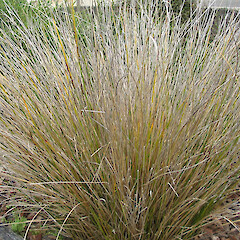Carex strictissima
Common name
bastard grass, hook sedge
Synonyms
Uncinia strictissima Petrie; Uncinia rigida Petrie non Boeck., U. rubra var. rigida (Petrie) Cheeseman, U. rubra var. strictissima Kuk
Family
Cyperaceae
Flora category
Vascular – Native
Endemic taxon
Yes
Endemic genus
No
Endemic family
No
Structural class
Sedges
NVS code
The National Vegetation Survey (NVS) Databank is a physical archive and electronic databank containing records of over 94,000 vegetation survey plots - including data from over 19,000 permanent plots. NVS maintains a standard set of species code abbreviations that correspond to standard scientific plant names from the Ngä Tipu o Aotearoa - New Zealand Plants database.
UNCSTR
Chromosome number
2n = 88
Current conservation status
The conservation status of all known New Zealand vascular plant taxa at the rank of species and below were reassessed in 2017 using the New Zealand Threat Classification System (NZTCS) – more information about this can be found on the NZTCS website. This report includes a statistical summary and brief notes on changes since 2012 and replaces all previous NZTCS lists for vascular plants.
Please note, threat classifications are often suggested by authors when publications fall between NZTCS assessment periods – an interim threat classification status has not been assessed by the NZTCS panel.
- Conservation status of New Zealand indigenous vascular plants, 2017 . 2018. Peter J. de Lange, Jeremy R. Rolfe, John W. Barkla, Shannel P. Courtney, Paul D. Champion, Leon R. Perrie, Sarah M. Beadel, Kerry A. Ford, Ilse Breitwieser, Ines Schönberger, Rowan Hindmarsh-Walls, Peter B. Heenan and Kate Ladley. Department of Conservation. Source: NZTCS and licensed by DOC for reuse under the Creative Commons Attribution 4.0 International licence.
2017 | Threatened – Nationally Endangered | Qualifiers: DP
Previous conservation statuses
2012 | Threatened – Nationally Endangered | Qualifiers: DP
2009 | Threatened – Nationally Endangered | Qualifiers: DP
2004 | Threatened – Nationally Endangered
Distribution
Endemic. In the North Island known only from the Central Volcanic Plateau. In the South Island it apparently has an easterly distribution, being recorded from the Nelson lakes, Canterbury, Otago and Southland.
Habitat
Lowland scrub, swamps, lake margins and in damp clears within lowland forest.
Wetland plant indicator status rating
Information derived from the revised national wetland plant list prepared to assist councils in delineating and monitoring wetlands (Clarkson et al., 2021 Manaaki Whenua – Landcare Research Contract Report LC3975 for Hawke’s Bay Regional Council). The national plant list categorises plants by the extent to which they are found in wetlands and not ‘drylands’. The indicator status ratings are OBL (obligate wetland), FACW (facultative wetland), FAC (facultative), FACU (facultative upland), and UPL (obligate upland). If you have suggestions for the Wetland Indicator Status Rating, please contact: [Enable JavaScript to view protected content]
FACW: Facultative Wetland
Usually is a hydrophyte but occasionally found in uplands (non-wetlands).
Detailed description
Dark olive-green to red-green rush-like sedge, forming dense tufts. Culms 300–550–(700) × 1 mm, initially trigonous and scabrid but maturing as terete and smooth (except for just under the inflorescence). Basal bracts dull dark brown. Leaves much reduced, inrolled or flat, 1–2 mm wide, rigid, strongly nerved, scabrid on margins, midrib bright red. Spikes 30–100 mm long, subtended by a reddish filiform bract > spike. Female flowers 10–15, distant in longer spikes, internodes up to 14 mm long at base but decreasing to 3 mm toward apex. Glumes ≤ utricles, persistent, obtuse or subacute, green to light brown, tinged pink. Utricles 6–7.5 × 2 mm, plano-convex, nerved, light brown, often pink near apex, stipe and beak up to 15 mm long.
Similar taxa
A distinctive species perhaps most closely allied to Carex erythrovaginata K.A.Ford from which it differs by the unusual, erect rush-like growth form and by the usually inrolled, (1)–2–3, 1 mm wide leaves.
Flowering
October–December
Fruiting
November–May (as the inflorescence is long persistent, fruits may be present all year round).
Propagation technique
Easily grown from fresh seed and the division of whole plants. Prefers cool, damp ground but once established will tolerate drought. Excellent in semi-shade.
Threats
Herbarium specimens indicate that this was never a common species. However, it is clear that it has declined over large parts of its range, and it is now very close to extinction in the North Island. The species seems to be threatened by habitat loss as a result of weed invasion and by animal browse.
Etymology
carex: Latin name for a species of sedge, now applied to the whole group.
strictissima: Very straight and narrow
Attribution
Fact sheet prepared for NZPCN by Peter J. de Lange 17 August 2006. Description adapted from Moore and Edgar (1970)
References and further reading
Moore LB, Edgar E. 1970. Flora of New Zealand, Volume II. Indigenous Tracheophyta: Monocotyledones except Gramineae. Government Printer, Wellington, NZ. 354 p.
NZPCN Fact Sheet citation
Please cite as: de Lange, P.J. (Year at time of access): Carex strictissima Fact Sheet (content continuously updated). New Zealand Plant Conservation Network. https://www.nzpcn.org.nz/flora/species/carex-strictissima/ (Date website was queried)








